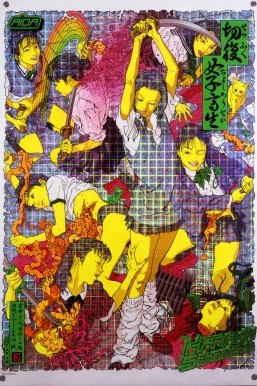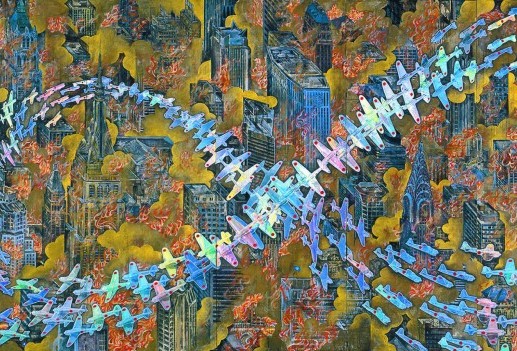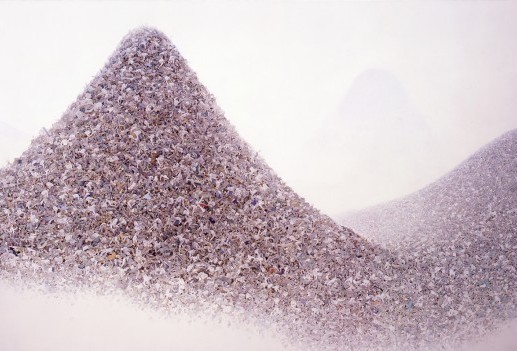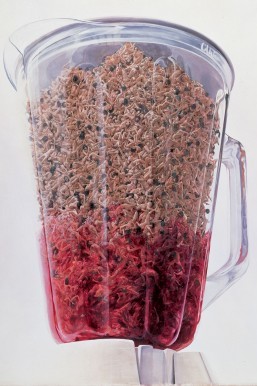Monuments to Misanthropy
These are a few of an artist’s favorite things—a giant blender shredding pretty young girls into a bloody milkshake; mountains of dead businessmen; and a giant woman being raped and killed by a giant three-headed dragon. The said favorites are images prolifically painted by Japanese artist Makoto Aida. In Japan he’s called the “bad-boy” of Japan’s contemporary art world. In the international art world he’s a misfit toy floating in a sea of misfit toys. For the first time in his 20-year career, Aida is having a retrospective exhibition at the Mori Art Museum.
Aida’s paintings typically depict war, pretty young girls, politics, and businessmen. They’re meticulously crafted images that erupt at first sight, as if to inflict visual schizophrenia. From the start, viewers are confronted by ‘Harakiri School Girls’ (2002), an acrylic painting on hologram film, layered with print on transparency film. At first glance, the young Japanese girls in school uniforms smirk. Up close, they gut themselves with swords in ritual suicide. A girl clings to her intestines as they slither from her gaping stomach. Another girl winks at you. A sword makes a rainbow as it cuts through air and into a girl’s neck. With one hand on the sword’s handle and the other around the end of the blade, you realize, she’s cutting her own head off. It’s a grotesque cohesion cinematically peaking in a single frame.

As described by the museum, the exhibition is randomly arranged, except for the “R-18” (rated for people over 18 years) room. It’s the last gallery of the exhibit, hidden behind black curtains. It’s what the inside of a popped cherry would look like if straight men unabashedly revealed their primordial instincts (will revisit later). To see Aida’s work in its entirety is like spiraling in all directions into the madness of a man who childishly plays with adult concepts and mocks would-be artists with vain aspirations. On a wall in the exhibit, Aida has written ten rules an artist should obey to become the greatest in the world. First, “never repeat the same thing twice.” Lastly, “don’t work and don’t make anything.”
Aida’s art includes painting, sculpture, installation and photography. His paintings reveal painstaking craftsmanship. They often reference Japan’s complicated history. Painted in 1996, ‘A Picture of an Air Raid on New York City (War Picture Returns),’ is a six-panel folding screen of prophetic 9/11 hysteria: Japanese warplanes figure-eight over burning midtown Manhattan buildings. The planes are hologram cutouts that change color when viewed from various angles. Aida was born in 1965, in Niigata, northern Japan, an area his parents recall American warplanes constantly bombing during World War II.
Painted in 1999, ‘Gate Ball (War Picture Returns)’ is an acrylic painting on a two-panel folding screen. Japanese senior veterans decapitate various citizens of Asia. The veterans’ faces are twisted and sadistically grinning. The backdrop is a map of East Asia. The image underscores but also belittles the atrocities committed by an imperialistic Japan during World War II. The veterans in the painting use the heads to play gateball (a game similar to croquet). One veteran is wearing a purple jacket with “The Great East Asia” written on the back; a reference to a Japanese version of manifest destiny. Imagine a Japanese elder from World War II gazing at this image: it’s as if Aida, in his own way, is accusing their generation of war crimes, while they live their last days under the shadow of a promising empire that never was.

For Aida, Japan’s centuries of history has been overrun by imported ideas. In an interview with Gadabout he said, “I often think of the Japanese as a mixed race comprised of Eurasians and those who traveled along the Pacific. Japanese tend to think of themselves as a pure race but they are actually extremely mixed, maybe much more so than say Koreans. Maybe that’s why there is no concrete Japanese-ness and the Japanese themselves are in a constant search for what makes us Japanese. To a degree it’s a focus of my works, as I find this ambiguity much more interesting than a definite answer to Japanese-ness.” He’s a self-described “wacko by Japanese standards.” Paradoxically, growing up in the countryside, he admits to also possessing a “traditional Japanese small village mentality.”
As side notes to this show, Aida added various video installations. In one called, ‘The Video of a Man Calling Himself Bin Laden Staying in Japan’ (2005), Aida impersonates Osama Bin Laden, lounging in Japan while sipping sake and talking about gaining weight after eating “awesome” Japanese food. In another, he shows how to use the ‘Demonstration Machine for One Person’ (2002). It samples and repeats everything you say while you drag it behind you, allowing you to lead a protest march alone. These videos are in the “Chaotic Room” with black walls, dim lighting, and a big cardboard temple. There’s also a pink tent decorated in all things “girly.” Assorted symbols of female adolescence and a cotton vagina embroidered on a pillow fill the inside. Next to the tent, a computer screen shows Aida unsuccessfully trying to hang himself in the ‘Instructional Video Attempted Suicide Machine’ (2001). Bleeps, glitches, bops, and zaps create a playful soundscape with flashes of horror as your eyes adjust to the surroundings. Several paintings hang in the dark; feces floating through space, an atomic penis cloud, a painted brain stretched and contorted over neatly arranged Japanese Yen, and a mural on panel of a school girl showing off her slit wrist.
One of the three new paintings on display is still in progress. ‘Jumble of 100 Flowers’ (2012-) is a 17-meter long acrylic painting on canvas. It resembles a video game in which the player shoots at the screen. The pixelated background mimics 8-bit graphics zoomed up close. Targets crawl across the canvas. Young naked girls with purple hair run towards you like zombies. They smile cutely. Shoot a girl in the head and she laughs. Instead of blood, jellybeans explode from her skull. Cuteness is the dominant aesthetic in Japan: for Aida, perhaps modern Japanese woman appear cute, but mindless. Men, unable to emotionally connect to the opposite gender, prefer pixelated versions of women that they can control and kill without conscience.

‘Ash Color Mountains’ (2009-2011), is an acrylic painting on a 300x700cm canvas. The painstaking detail is awe-inspiring. Mountains of dead businessmen piled on top of each other. Each corpse was finely painted and intertwined with those around it. From a distance it resembles the ashtray of a giant who chain-smokes. Up close, it’s the conclusion to a businessman’s life. Like an obsolete machine, after it’s lived out its usefulness, it gets discarded.
‘Blender’ (2001) is an acrylic-on-canvas exercise in sadomasochism. Standing at 290cm, a huge blender minces young Japanese girls into a bloody mixture. Their facial expressions are clearly visible: blank, aroused, clueless and pleasured. The way their naked bodies swirl inside the container and press against the glass animates their individual features. In a conservative country like Japan, it’s common to walk into a convenience store and see a comic book next to the front cover of a half naked woman tied up and grinning. Easy access to such material became influential to a young Aida. “I used to peek at such things on the sly, with a touch of guilt and slightly shameful feeling. Those times, looking back on them now, I can see as being very satisfying,” he said in a Japan Times article.

Aida originally wanted to be a writer like his hero, Yukio Mishima. He couldn’t write, but he could draw. In the early 90’s, he wanted to produce manga like Katsuhiro Otomo (Akira) and Masamune Shirow (Ghost In The Shell). He couldn’t tell a story, but he was an artist inspired by novelists. Enter ‘The Giant Member Fuji versus King Gidora’ (1993), an acrylic painting on acetate film. It’s a giant woman getting raped and killed by a giant three-headed dragon. It is inspired by Katsushika Hokusai’s woodblock print, ‘The Dream of a Fisherman’s Wife’ (c. 1820), as well as mixing monster movies and a character from the animation, Battleship Yamato. ‘The Giant Member’ moved Aida away from stabbing-in-the-dark-attempts at manga and into fine arts. He gained a following and a reputation for illustrating morbidity and eroticism.
Enter the R-18 room, where Aida’s beginnings as an artist are on display, and visitors will reach the climax of the show (pun intended). In the corner, there’s an hour long video of the artist masturbating in front of painted Japanese characters that translate into pretty young girls. There’s the ‘Dog’ series, a Japanese nihonga style series of paintings, which are a disturbingly unforgettable collection of images of women portrayed as dogs. Their necks are in chains or leashes. Their hands and half their legs are cut off. The rich pastel colors with their subtle textures and fading reflections conflict with the image’s content. Using Japanese mineral pigment and acrylic on Japanese paper mounted on panel, the paintings are delicate illustrations that expand and retract between beauty and grotesque.
This retrospective show is no doubt an unlikely match—Tokyo’s leading contemporary art museum is celebrating an artist that is viewed as insane, perverted or a genius, depending on whom you talk to. Still, it’s long overdue. Aida’s work is strikingly original, a by-product of suppressed emotions and unspoken issues that permeate Japanese society. In a creative context, Aida struggles between who he is and the societal standards placed upon him. He’s a master craftsman that throughout the years has endured. Aida is a man of his time, but with this landmark show, it would seem that the times have finally caught up with him.
Tracy Jones
Tracy Jones



